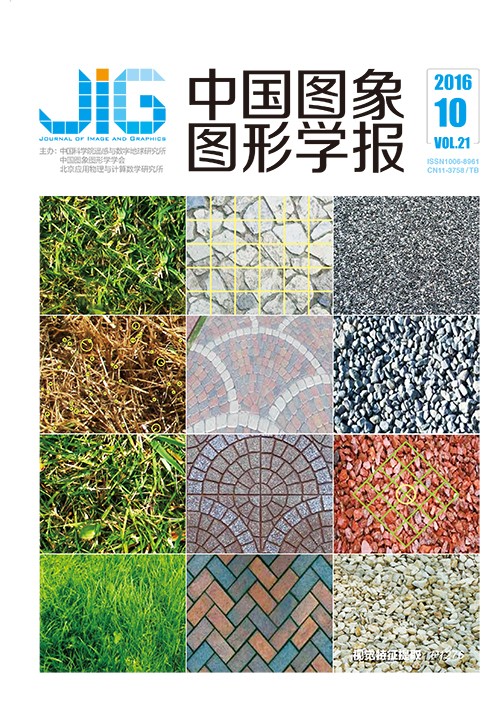
基于人脸认知模式的相似脸搜索
李彤1, 曹卫群1, 刘晶晶2, 张杰3, 石苗4(1.北京林业大学信息学院, 北京 100083;2.德国自由大学动物医学院, 柏林 14195;3.中国工商银行软件开发中心, 北京 100193;4.中影电影数字制作基地有限公司北京影视后期制作分公司, 北京 101400) 摘 要
目的 人类对人脸认知模式的探索由来已久,并且已经成功应用于美容整形等研究领域。然而,目前在计算机视觉和模式识别领域,计算人脸相似度的方法没有考虑人对人脸的认知模式,使得现有方法的计算结果从人的认知习惯角度来讲并非最佳。为克服以上缺陷,提出一种基于人脸认知模式的相似脸搜索算法。方法 依据人脸认知模式,选取特征点,并计算特征量,构造各面部器官(眼睛、鼻子、嘴巴、脸型)分类模型,即面部器官形状相似性度量模型,并采用圆形LBP算子,计算两幅人脸对应器官的纹理相似度,二者综合作为相似脸搜索的依据。结果 分别用本文方法和代表相似脸搜索最高水平的Face++的方法对80幅正面、中性表情、平视角度拍摄的人脸图像进行测试。本文方法的整体准确率高于Face++方法,其中,TOP1、TOP2最相似搜索结果准确率优势明显,均高出Face++方法12%以上。结论 实验结果表明,本文方法的搜索结果更加符合人脸认知模式,可应用于正面、中性表情、平视角度拍摄的人脸图像的相似脸搜索。此外,还可以将此类基于认知模式的图像搜索思路推广应用于商业领域,如基于图像的相似网购商品搜索等。
关键词
Similar face search based on face cognition
Li Tong1, Cao Weiqun1, Liu Jingjing2, Zhang Jie3, Shi Miao4(1.School of Information Science and Technology, Beijing Forestry University, Beijing 100083, China;2.Department of Veterinary Medicine, Freie University Berlin, Berlin 14195, Germany;3.Beijing R & D Department, Software Development Centre, ICBC., Beijing 100193, China;4.State Production base of China Film Co. Ltd. Post Production, Beijing 101400, China) Abstract
Objective Research on face recognition models has a long history, and has been successfully used in cosmetic surgery and other fields. Meanwhile, exploration of facial similarity measure methods has been conducted in the fields of computer vision and pattern recognition. Some applications, such as face recognition, face retrieval, and similar face search applications, have been widely used in many fields. Existing methods that measure face similarity are typically confined to calculating image similarity without incorporating face cognition patterns used by human beings. Therefore, results of current methods are usually less than optimal from the perspective of human cognitive habits. Method Based on face cognition patterns, each kind of facial feature, such as eyes, nose, mouth, and facial shape, is divided into several common types. For example, eyes are divided into 10 groups such as phoenix, circle, triangle, and others. After analyzing feature vectors of different types, we pick 20 images from CAS-PEAL-R1 database for each common type of every facial feature to locate feature points and calculate feature values. We use statistical values of the results to construct facial feature classification models, i.e., contour similarity measurement models for facial features. Contour information cannot include certain facial details, e.g., fold eyelid, high nose bridge, and so on. To measure similarity of details between two faces, we employ a circular local binary pattern operator to calculate the texture similarity of corresponding facial features. A combination of contour and texture similarities is used as criterion for a similar face search. Result Our test face database contains 80 frontal neutral and head-angle face images collected from the Internet; these images are different from the aforementioned training images. Our target face database consists of two parts: 1 040 frontal images in the CAS-PEAL-R1 database and 102 star identification photos collected from the Internet. Only a few CAS-PEAL database images are allowed to be presented in papers, so extra star photos are added to the target face database. We use our method and the method provided by Face++, which presents the highest level of similar face research, to search most similar faces for each test-face image from the target face database. Statistically, the overall accuracy of our method is higher than that of Face++. TOP1 and TOP2 retrieval results are obviously better than Face++, with accuracy rate gaps both reaching more than 12%. Conclusion Experimental results show that the search results of our method are more satisfactory from the perspective of human cognitive habits. Thus, our method can be applied to search similar faces for frontal neutral and head-angle face images. Besides, the proposed image search approach based on cognitive models can also be applied in the business sector, e.g., image-based similarity search of online goods.
Keywords
|



 中国图象图形学报 │ 京ICP备05080539号-4 │ 本系统由
中国图象图形学报 │ 京ICP备05080539号-4 │ 本系统由